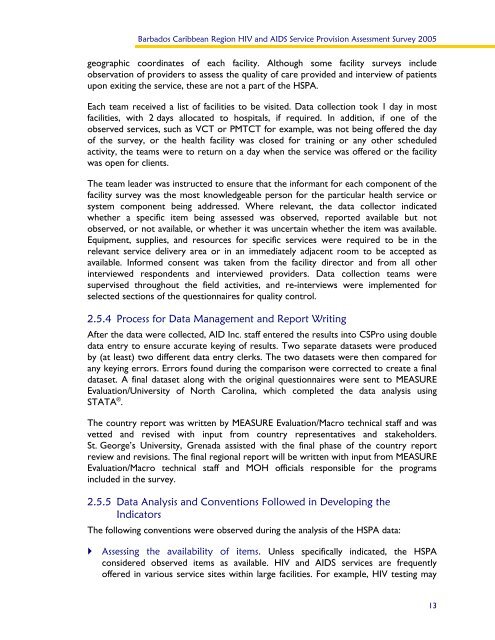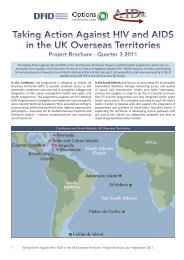Barbados - Carolina Population Center
Barbados - Carolina Population Center
Barbados - Carolina Population Center
Create successful ePaper yourself
Turn your PDF publications into a flip-book with our unique Google optimized e-Paper software.
<strong>Barbados</strong> Caribbean Region HIV and AIDS Service Provision Assessment Survey 2005<br />
geographic coordinates of each facility. Although some facility surveys include<br />
observation of providers to assess the quality of care provided and interview of patients<br />
upon exiting the service, these are not a part of the HSPA.<br />
Each team received a list of facilities to be visited. Data collection took 1 day in most<br />
facilities, with 2 days allocated to hospitals, if required. In addition, if one of the<br />
observed services, such as VCT or PMTCT for example, was not being offered the day<br />
of the survey, or the health facility was closed for training or any other scheduled<br />
activity, the teams were to return on a day when the service was offered or the facility<br />
was open for clients.<br />
The team leader was instructed to ensure that the informant for each component of the<br />
facility survey was the most knowledgeable person for the particular health service or<br />
system component being addressed. Where relevant, the data collector indicated<br />
whether a specific item being assessed was observed, reported available but not<br />
observed, or not available, or whether it was uncertain whether the item was available.<br />
Equipment, supplies, and resources for specific services were required to be in the<br />
relevant service delivery area or in an immediately adjacent room to be accepted as<br />
available. Informed consent was taken from the facility director and from all other<br />
interviewed respondents and interviewed providers. Data collection teams were<br />
supervised throughout the field activities, and re-interviews were implemented for<br />
selected sections of the questionnaires for quality control.<br />
2.5.4 Process for Data Management and Report Writing<br />
After the data were collected, AID Inc. staff entered the results into CSPro using double<br />
data entry to ensure accurate keying of results. Two separate datasets were produced<br />
by (at least) two different data entry clerks. The two datasets were then compared for<br />
any keying errors. Errors found during the comparison were corrected to create a final<br />
dataset. A final dataset along with the original questionnaires were sent to MEASURE<br />
Evaluation/University of North <strong>Carolina</strong>, which completed the data analysis using<br />
STATA ® .<br />
The country report was written by MEASURE Evaluation/Macro technical staff and was<br />
vetted and revised with input from country representatives and stakeholders.<br />
St. George’s University, Grenada assisted with the final phase of the country report<br />
review and revisions. The final regional report will be written with input from MEASURE<br />
Evaluation/Macro technical staff and MOH officials responsible for the programs<br />
included in the survey.<br />
2.5.5 Data Analysis and Conventions Followed in Developing the<br />
Indicators<br />
The following conventions were observed during the analysis of the HSPA data:<br />
Assessing the availability of items. Unless specifically indicated, the HSPA<br />
considered observed items as available. HIV and AIDS services are frequently<br />
offered in various service sites within large facilities. For example, HIV testing may<br />
13





